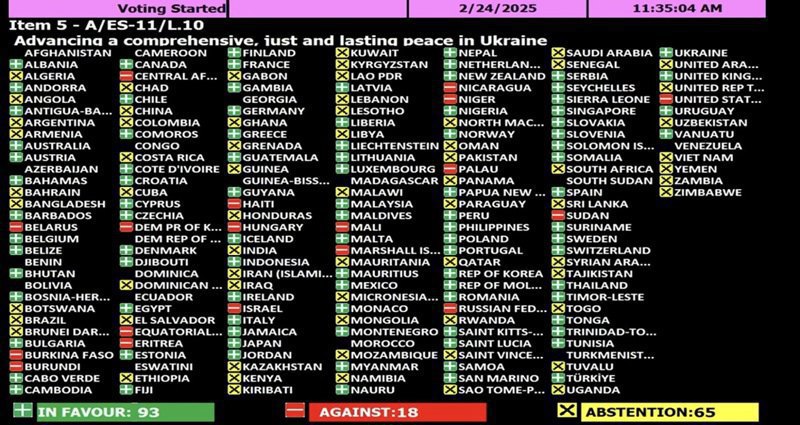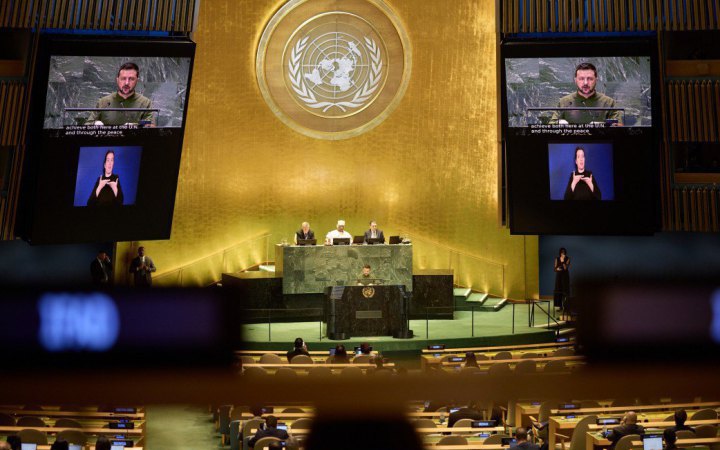On 24 February, the UN General Assembly supported both Ukrainian and American draft resolutions marking the third anniversary of Russia’s war. While both call for an end to the war in Ukraine, they contain key differences.
The Ukrainian resolution identifies Russia as the aggressor and demands the full withdrawal of Russian troops from Ukraine’s internationally recognised borders. In contrast, the US resolution does not explicitly recognise Russia as an aggressor and includes an amendment on “the need to address the root causes of the Ukrainian crisis”.
Notably, during the vote on Ukraine’s resolution, the United States - alongside Russia - voted against it, while Ukraine abstained from voting on the American version.
Deputy Foreign Minister of Ukraine Mariana Betsa also addressed the UN General Assembly.
She emphasised that the only way to achieve a comprehensive, just, and lasting peace is by upholding the UN Charter and ensuring that its core principles - sovereignty and territorial integrity within internationally recognised borders - form the foundation of the global order.
“We are fighting for a world that can no longer be divided by a new Molotov-Ribbentrop Pact. We are defending a world in which the future of nations is not decided behind the closed doors of another Yalta conference,” Betsa stated.
The US resolution
The US resolution, Path to Peace, does not acknowledge Russian aggression. Moreover, it does not mention Russia’s full-scale invasion of Ukraine, which began three years ago on this day.
Instead, it calls for “a swift end to the conflict and a lasting peace between Ukraine and the Russian Federation”.
US Secretary of State Marco Rubio stressed that this resolution aimed to “reaffirm that the conflict is terrible, that the UN can help end it, and that peace is possible”, describing it as an opportunity to create “momentum for peace”.
The UN General Assembly adopted the US Path to Peace resolution, though three amendments were added at the request of European countries:
- The phrase “conflict between the Russian Federation and Ukraine” was replaced with “full-scale invasion of Ukraine by the Russian Federation.”
- A clause reaffirming the commitment to Ukraine’s sovereignty, independence, unity, and territorial integrity within its internationally recognised borders, including its territorial waters, was included.
- The wording on a “lasting peace between Ukraine and Russia” was replaced with “a just, lasting, and comprehensive peace between Ukraine and the Russian Federation, in accordance with the Charter of the United Nations and the principles of sovereign equality and territorial integrity of states.”
The amended resolution was supported by 93 countries, with 8 voting against and 73 abstaining. Notably, the United States abstained from voting on its own amended resolution.
The day before, the Trump administration had asked Ukraine to withdraw its annual UN resolution condemning Russia’s war, proposing instead a softened Road to Peaceresolution.
Ukraine’s resolution
Ukraine’s expanded resolution, Promoting a comprehensive, just and lasting peace in Ukraine, states that Russia’s invasion “has been ongoing for three years and continues to have devastating and long-term consequences, not only for Ukraine but also for other regions and global stability.”
The resolution calls for an immediate cessation of hostilities, a peaceful resolution to the war, and an end to the conflict this year.
It also reiterates that previous UN General Assembly resolutions must be fully implemented, including those demanding Russia’s complete withdrawal from Ukraine’s internationally recognised borders.
The day before the vote, Russia’s representative to the UN, Vasiliy Nebenzya, urged countries to vote against the resolution. In the final vote, 93 countries supported it, 18 voted against, and 65 abstained. Interestingly, the United States and Israel voted against the Ukrainian resolution, aligning with Russia and Belarus.

The General Assembly also reaffirmed its commitment to Ukraine’s sovereignty, independence, unity, and territorial integrity within its internationally recognised borders, stressing that “no territorial acquisition resulting from the threat or use of force should be recognised as legal”.
What does this mean, and what’s next?
“It would be a mistake to see this as a case of two resolutions where the ‘Ukrainian version’ won by just one vote. In reality, the Americans’ original plan was changed completely, as three European amendments were incorporated into their text, radically altering it. Essentially, the Americans scored an own goal, and we ended up with two resolutions - both of which work in our favour,” a Ukrainian official involved in the process told Lb.ua.
The UN Security Council is set to meet at 3 p.m. New York time, where the United States is expected to propose a similar resolution. To pass, it will need at least nine votes (Ukraine is preliminarily backed by six member states). A key factor will be China’s position, as it has twice abstained from voting on similar resolutions.








